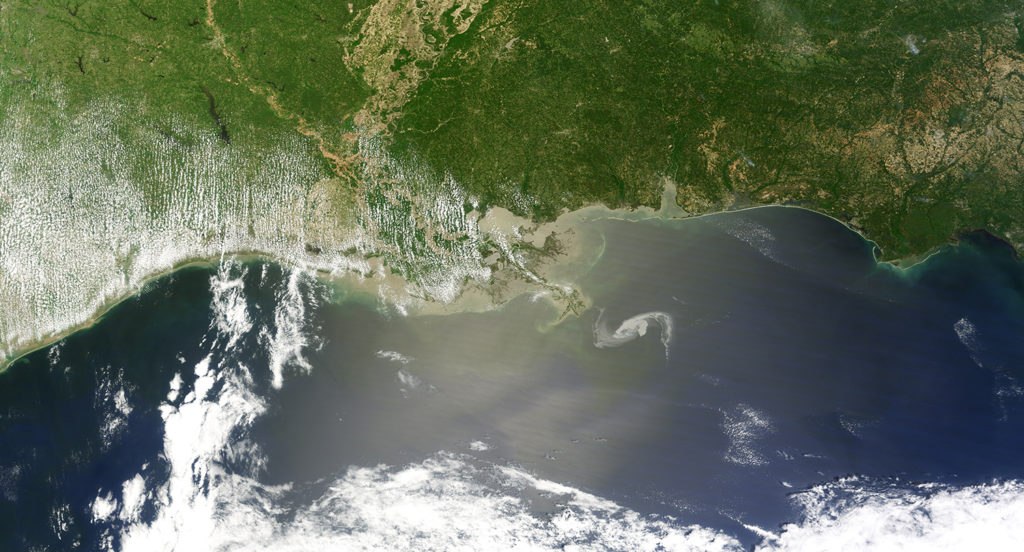Metagenome pipeline helps researchers resolve near-complete microbial genomes involved in Deepwater Horizon oil spill.
The Science

The oil slick in the Gulf of Mexico from the Deepwater Horizon oil spill as seen on April 29, 2010. (NASA Earth Observatory image created by Jesse Allen, using data provided courtesy of the University of Wisconsin’s Space Science and Engineering Center MODIS Direct Broadcast system)
The 2010 Deepwater Horizon oil spill released 4.1 million barrels of oil into the Gulf of Mexico and was the first major release of oil and natural gases into the deep ocean (1,500 meters). Due to the depth of the spill, vast plumes of small oil droplets remained trapped deep in the ocean (900-1,300 meters) where they underwent biodegradation by the local microbial community. Until now, researchers have been puzzled over the metabolic capabilities driving the shifts between microbial communities to degrade the crude oil. In this study researchers have been able to present the first complete picture of how successive waves of microbial populations degraded the released oil. They were also able to recover high-quality genomes of the key microbial players, and determine the metabolic factors driving the shifts between microbial communities.
The Impact
Identifying the microbes involved in degrading hydrocarbons (the chief components of petroleum and natural gas), as well as the drivers that trigger successive waves of microbial responders, allows researchers to better understand how the microbial community adapted to the events of seven years ago. The expertise and resources used to reconstruct the microbial genomes demonstrates how new technology development at the U.S. Department of Energy Joint Genome Institute (DOE JGI), a DOE Office of Science User Facility, is enabling energy and environment research.
Summary
In the three months between the time the Deepwater Horizon Macondo well exploded on April 22, 2010 until it was capped in mid-July, thousands of barrels of oil and large quantities of natural gases flowed into the Gulf of Mexico on a daily basis. A team led by researchers at Lawrence Berkeley National Laboratory (Berkeley Lab) reproduced the dispersal to replicate the successive populations of diverse microbes over 64 days and recover high-quality draft genomes to determine metabolic factors driving microbial community shifts. They discovered that the microbial community transformed with chemical changes in residual oil. Additionally, their lab-based method allowed for the first time the successful resolution of high-quality genomes and the characterization of functional capabilities for all the key microbes.
Samples from three time points (days 6, 18, and 64) were chosen for metagenomic sequencing and analysis. Assembled genome fragments were binned or assigned to draft genomes of origin using resources provided by the DOE JGI’s Emerging Technologies Opportunity Program (ETOP). ETOP was launched in 2013 to support new technology development at other institutions that, once perfected, could then be deployed by the DOE JGI and its users to tackle energy and environment applications. This research demonstrates the rapid, specialized biodegradation by the deep ocean microbial community was possibly driven by crude oil alone.
BER Contact
Daniel Drell, Ph.D.
Program Manager
Biological Systems Sciences Division
Office of Biological and Environmental Research
Office of Science
US Department of Energy
daniel.drell@science.doe.gov
PI Contacts
Susannah Tringe
Deputy, User Programs
DOE Joint Genome Institute
sgtringe@lbl.gov
Gary Andersen
Earth & Environmental Systems Area
Lawrence Berkeley National Laboratory
glandersen@lbl.gov
Funding
This work was supported by a subcontract from the University of California, Berkeley Energy Bioscience Institute to Lawrence Berkeley National Laboratory under its US Department of Energy Contract DE-AC02-05CH11231. Work done by the DOE JGI was also through Contract DE-AC02-05CH11231. Other funding was provided by BP Exploration & Production Inc., the BP Gulf Coast Restoration Organization through Florida International University Project 800001556, and Deutsche Forschungsgemeinschaft Grant PR1603/1-1.
Publication
- P. Hu, E.A. Dubinsky, A.J. Probst, J. Wang, C.M.K. Sieber, L.M. Tom, P.R. Gardinali, J.F. Banfield, R.M. Atlas, GL Andersen. “Simulation of Deepwater Horizon oil plume reveals substrate specialization within a complex community of hydrocarbon degraders.” Proc Natl Acad Sci U S A. 2017 Jun 26. doi:10.1073/pnas.1703424114
Related Links
- Berkeley Lab News Release: Microbe Mystery Solved: What Happened to the Deepwater Horizon Oil Plume
- DOE JGI Emerging Technologies Opportunity Program
- Examining a predominant Deepwater Horizon microbe
- Hope for Re-establishing Gulf of Mexico Microbial Populations
- Waves of Berkeley Lab Responders Deploy Omics to Track Deepwater Horizon Oil Spill Cleanup Microbes
- Terry Hazen on “The Gulf Oil Spill: Ecogenomics and Ecoresilience” at the 2011 DOE JGI Genomics of Energy and Environment Meeting